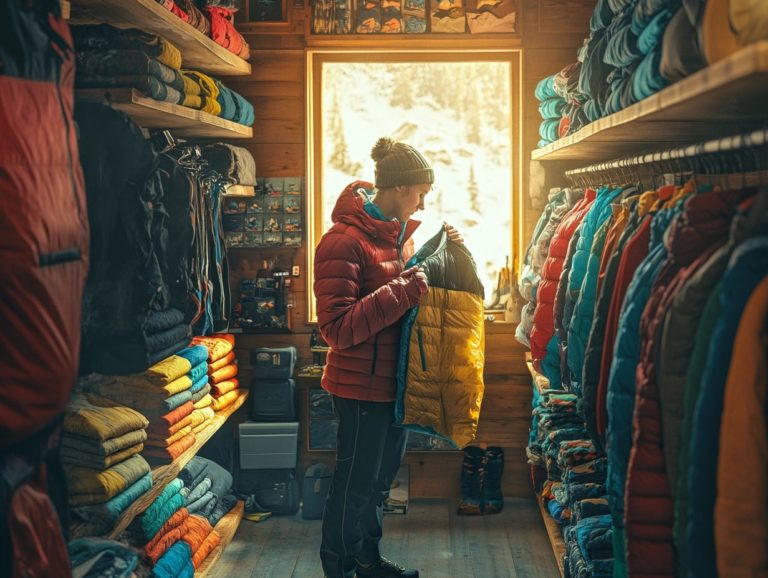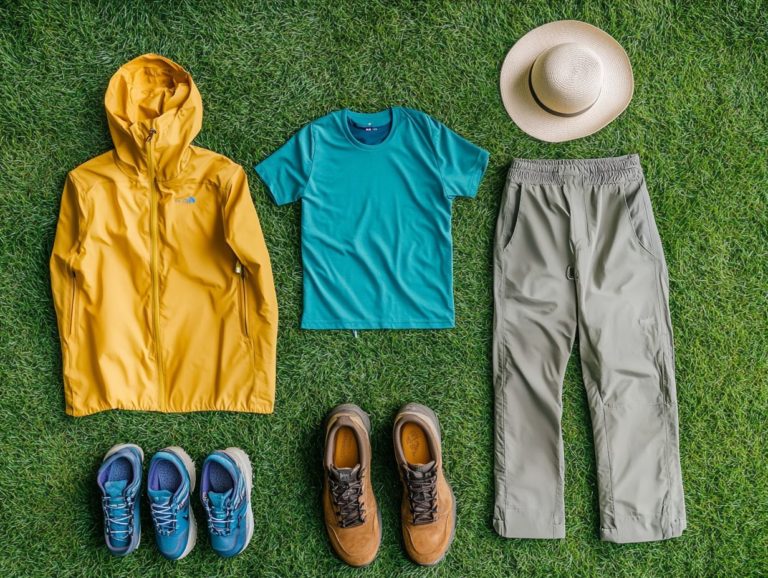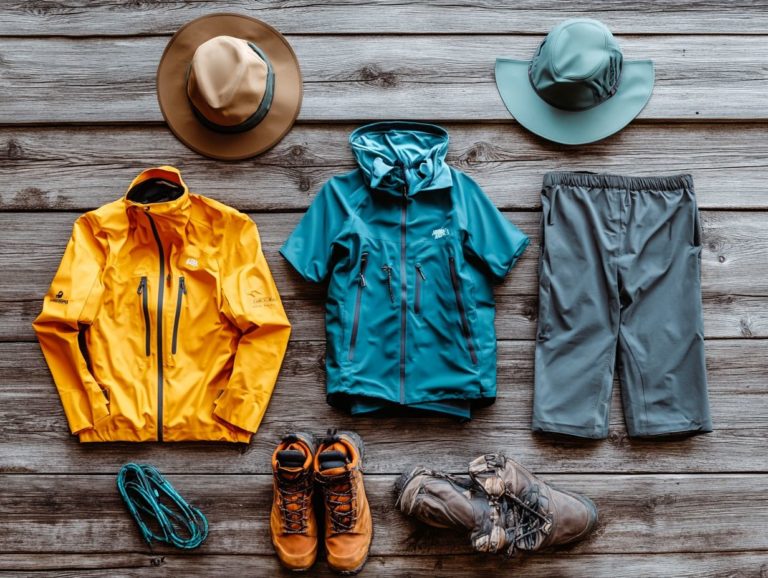Layering for Warmth: A Guide for Winter Hikes
Get ready to conquer the cold! When it comes to winter hiking, ensuring that you stay warm and comfortable is essential for a truly enjoyable experience.
Layering your clothing is key; it not only helps regulate your body temperature but also provides the flexibility to adapt to shifting weather conditions.
This guide delves into the significant benefits of cold weather layering, breaks down the various types of layers from base layers to outer layers and shares effective techniques for navigating different weather scenarios. You ll also find valuable tips on selecting the right materials and packing efficiently. Prepare to embrace the winter wilderness with confidence!
Contents
- Key Takeaways:
- Why Layering is Important for Winter Hikes
- Types of Winter Layers
- Layering Techniques for Different Weather Conditions
- Tips for Choosing and Packing Layers
- Frequently Asked Questions
- What is layering and why is it vital for winter hikes?
- What are the different layers recommended for winter hikes?
- How should I choose the right base layer for winter hikes?
- Can I wear multiple base layers for extra warmth?
- Is it necessary to have a waterproof outer layer for winter hikes?
- What about accessories for warmth on winter hikes?
Key Takeaways:
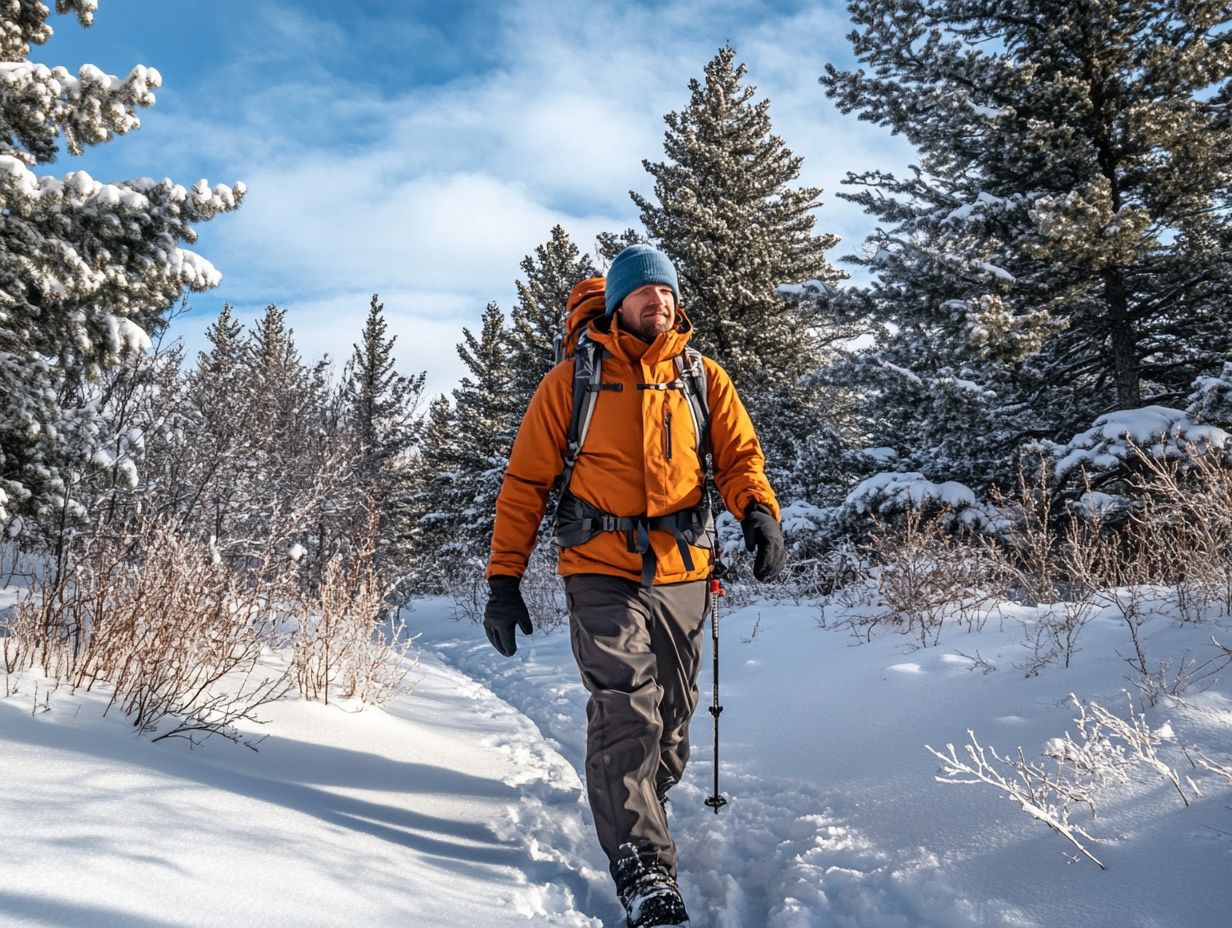
- Layering is vital for staying warm on winter hikes, providing insulation and temperature control.
- The three types of layers are base, mid, and outer, each with their own purpose in keeping you warm and dry.
- Choose your layers based on the weather, and packing efficiently is key for a comfortable and safe winter hike.
Why Layering is Important for Winter Hikes
Layering is essential for winter hiking, particularly in varied environments like the Canadian Rockies or Patagonia, where weather can shift dramatically. A well-planned layering system not only keeps you warm but also manages moisture, ensuring you remain comfortable and dry on your outdoor adventures.
Learning how to layer properly helps you avoid serious problems like frostbite or hypothermia, making it a vital skill for any winter hiker. With the right cold-weather gear, you can fully embrace trekking, snowshoeing, or any winter activity while effortlessly maintaining your desired temperature and activity levels.
Benefits of Layering for Warmth
The primary advantage of layering during winter hikes is the enhanced warmth it provides, allowing you to adapt seamlessly to changing temperatures and your activity levels. There are three main types of layers: base layers, mid layers, and outer layers, each delivering unique benefits.
Base layers, often made from materials like merino wool or synthetic fibers, excel at keeping moisture away from your skin, ensuring you stay dry and comfortable.
Mid layers, such as fleece or down, are designed to trap heat while remaining breathable, so you can maintain warmth without the risk of overheating during more intense activities.
Outer layers, typically crafted from windproof and waterproof materials, offer essential protection against harsh elements like wind and snow. Together, this cohesive system acts as a versatile shield against the cold, enabling you to enjoy your winter adventures without sacrificing comfort or safety.
Types of Winter Layers
Understanding the various types of winter layers is essential for any winter hiking enthusiast, as each layer serves a crucial purpose in insulation, moisture management, and overall comfort.
The base layer, often crafted from materials such as merino wool or synthetic fabrics, rests closest to your skin and efficiently wicks away moisture. The mid layer offers additional insulation through items like thermal tights or fleece jackets.
Lastly, the outer layer is your safeguard against the elements, protecting you from wind, snow, and rain; you have choices that range from waterproof jackets to insulated trekking pants. Together, these layers form a cohesive system that significantly enhances your winter hiking experience.
Base Layers
Base layers are the cornerstone of your winter hiking wardrobe. They expertly manage moisture and provide warmth while keeping you comfortable against your skin.
These essential garments protect you by regulating body temperature. They keep you comfortable whether you re trekking through snow or brisk mountain trails.
Choosing the right fabric is key. Merino wool stands out due to its natural insulating properties, breathability, and odor resistance, making it the top choice for outdoor adventures.
On the flip side, synthetic materials dry quickly and offer added durability, though they may not provide the same level of warmth. When selecting a base layer, think about the fit snug yet comfortable is the ideal balance. Consider your activity level and personal temperature preferences to ensure the best performance during your adventures.
Mid Layers
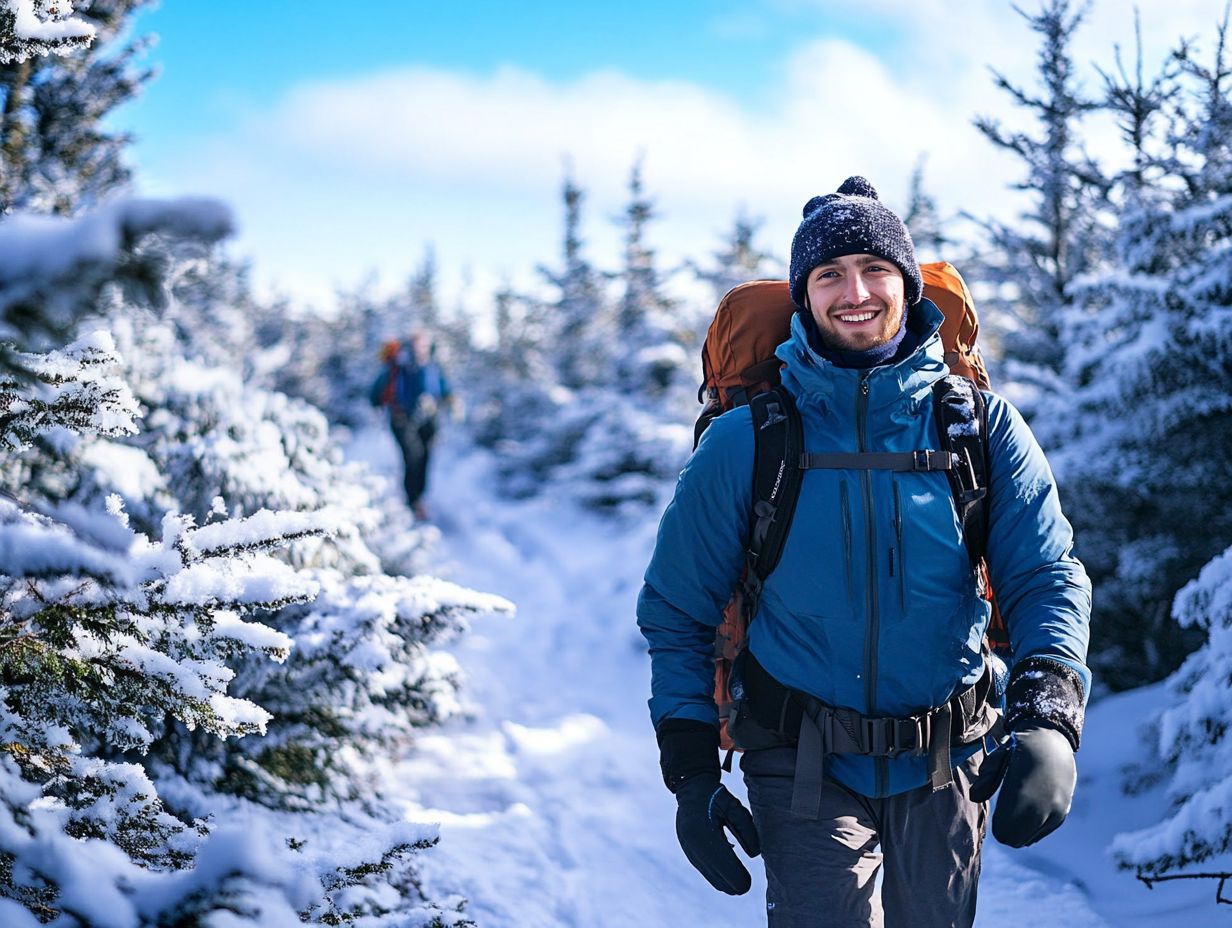
Mid layers play a crucial role in your winter hiking experience by providing essential insulation. They effectively trap your body heat while allowing moisture to escape, which is vital for your comfort.
You have a range of options for these layers, including fleece jackets and thermal tights. These garments are designed to enhance warmth without adding bulk.
Fleece jackets, crafted from lightweight synthetic materials, do an excellent job of retaining heat while remaining breathable. Thermal tights, often made from technical fabrics, offer an extra layer of insulation for your legs, helping to minimize heat loss.
The effectiveness of your mid layers can vary depending on the materials you choose, like merino wool or polyester blends. Merino wool excels at managing moisture and odor, while synthetic fibers dry quickly ideal for wet conditions. Knowing these details can boost your comfort and performance on the trails!
Outer Layers
Outer layers serve as your first line of defense against harsh winter conditions. They are meticulously designed for weather protection that keeps you dry and comfortable.
When selecting gear for winter hiking, consider various types of outer layers. Waterproof jackets provide a shield against rain and snow, while insulated pants retain warmth without sacrificing mobility.
Look for garments that feature breathability, allowing sweat to escape while effectively blocking out the chill. Wind-resistant products are invaluable, ensuring you maintain body warmth during gusty conditions.
Reputable brands like Patagonia, The North Face, and Columbia are known for producing reliable outdoor gear tailored to extreme weather. With their offerings, you can embark on your adventures with confidence, knowing that safety and comfort are never compromised.
Layering Techniques for Different Weather Conditions
The effectiveness of your layering system can shift significantly based on the weather conditions during winter hiking. In cold and dry weather, a straightforward layering technique that emphasizes warmth and moisture management will keep you comfortable throughout your adventure.
When you face wet and windy conditions, add weather-resistant outer layers to shield yourself from the elements. Customizing your layering strategies for varying conditions enhances your comfort and mitigates risks like hypothermia and frostbite. For a successful outing, be sure to include winter hiking gear essentials in your preparation. This ensures that each winter hike remains a safe and enjoyable experience.
Layering for Cold and Dry Weather
When layering for cold and dry weather, your aim is to keep warm while skillfully managing moisture to avoid that unpleasant sweat buildup.
To achieve this, begin with a high-quality base layer crafted from materials like merino wool or synthetic fabrics that efficiently wick moisture away from your skin. This base layer should fit snugly, enhancing insulation without limiting your movement.
Your mid-layer whether it s fleece or an insulated material will trap heat while allowing for breathability. Finish with an outer layer that s both waterproof and windproof, serving as a sturdy shield against the elements.
By thoughtfully combining these layers, you ll ensure optimal comfort and warmth, allowing you to savor outdoor activities even in the harshest conditions. Get ready to tackle the cold!
Layering for Wet and Windy Weather
In wet and windy weather, effective layering is essential for keeping you comfortable and protected during your winter hikes.
To ensure a pleasant outdoor experience, focus on choosing the right materials for each layer, especially the outer one. Weather-resistant fabrics are crucial; they shield you from rain and wind while allowing moisture to escape from beneath. Striking this balance prevents overheating and maintains a dry microclimate next to your skin. For core insulation, opt for materials like down or man-made materials that provide warmth without bulk.
When planning your next adventure, investing in quality gear is essential. Look for waterproof jackets, breathable base layers, and top accessories for winter hiking that work together for optimal performance.
Tips for Choosing and Packing Layers
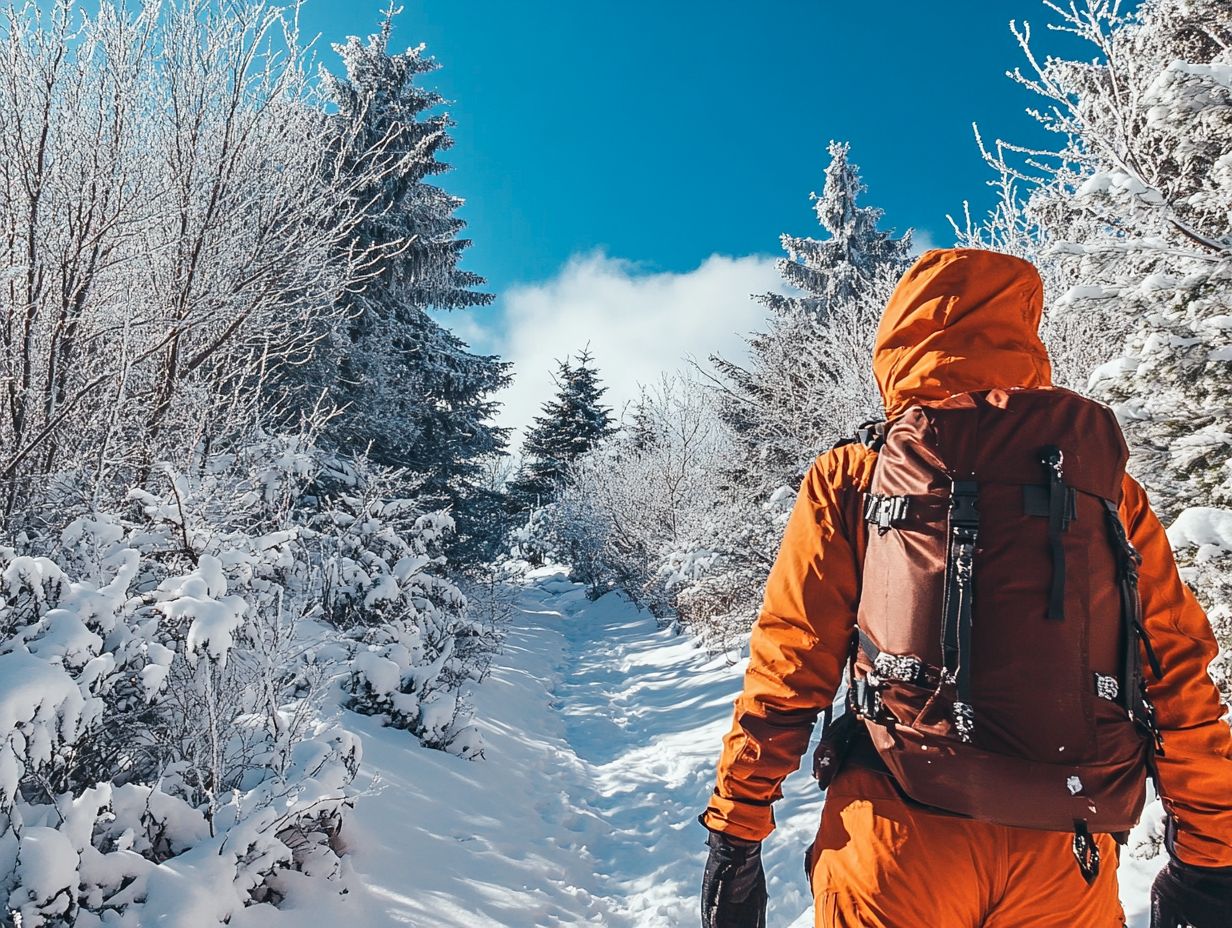
Selecting and packing the right layers for winter hiking can elevate your outdoor adventure, ensuring you’re well-prepared for varying conditions and activity levels.
When you choose your layers, pay attention to both the materials and the fit. A base layer crafted from merino wool, for example, offers exceptional moisture management and warmth. A fitted mid-layer can trap heat effectively without adding bulk. Additionally, it’s crucial to follow best practices for winter hiking to ensure a safe and enjoyable experience.
As you pack your cold-weather gear, prioritize lightweight and versatile pieces that you can easily adjust or remove as conditions shift. This approach helps maintain comfort and safety throughout your hike.
Choosing the Right Materials
Choosing the right materials for your winter layers is essential for effective moisture management and insulation during your hikes.
This decision becomes critical when you consider the diverse conditions you might encounter, from biting winds to unexpected snowfalls. Merino wool emerges as an exceptional choice, offering natural warmth, breathability, and the ability to pull sweat away from your skin, keeping you comfortable in fluctuating temperatures.
On the other hand, synthetic materials often shine in terms of durability and quicker drying times, making them a practical option for high-intensity activities.
As you assess your winter gear, think about the nature of your adventure and the prevailing weather conditions. Use this knowledge to choose the best fabrics for an amazing outdoor adventure!
Packing Efficiently for Winter Hikes
Efficient packing for winter hikes can greatly enhance your comfort and preparedness, especially in cold weather conditions.
By organizing your layers for quick access to essential items, you can navigate unpredictable weather shifts with ease. Consider utilizing lightweight and multi-functional gear; this not only lightens your load but also maximizes utility. For example, opting for a jacket that functions as both insulation and a shell can be a true game-changer.
Tailor your packing strategy to the hike s duration and nature, ensuring that essentials like extra socks and snacks are easily reachable. This approach helps maintain your energy and comfort throughout the trek.
Frequently Asked Questions
What is layering and why is it vital for winter hikes?
Layering is the technique of wearing multiple layers of clothing to stay warm in cold weather. It is important for winter hikes because it allows for better temperature regulation and protection from the elements.
What are the different layers recommended for winter hikes?
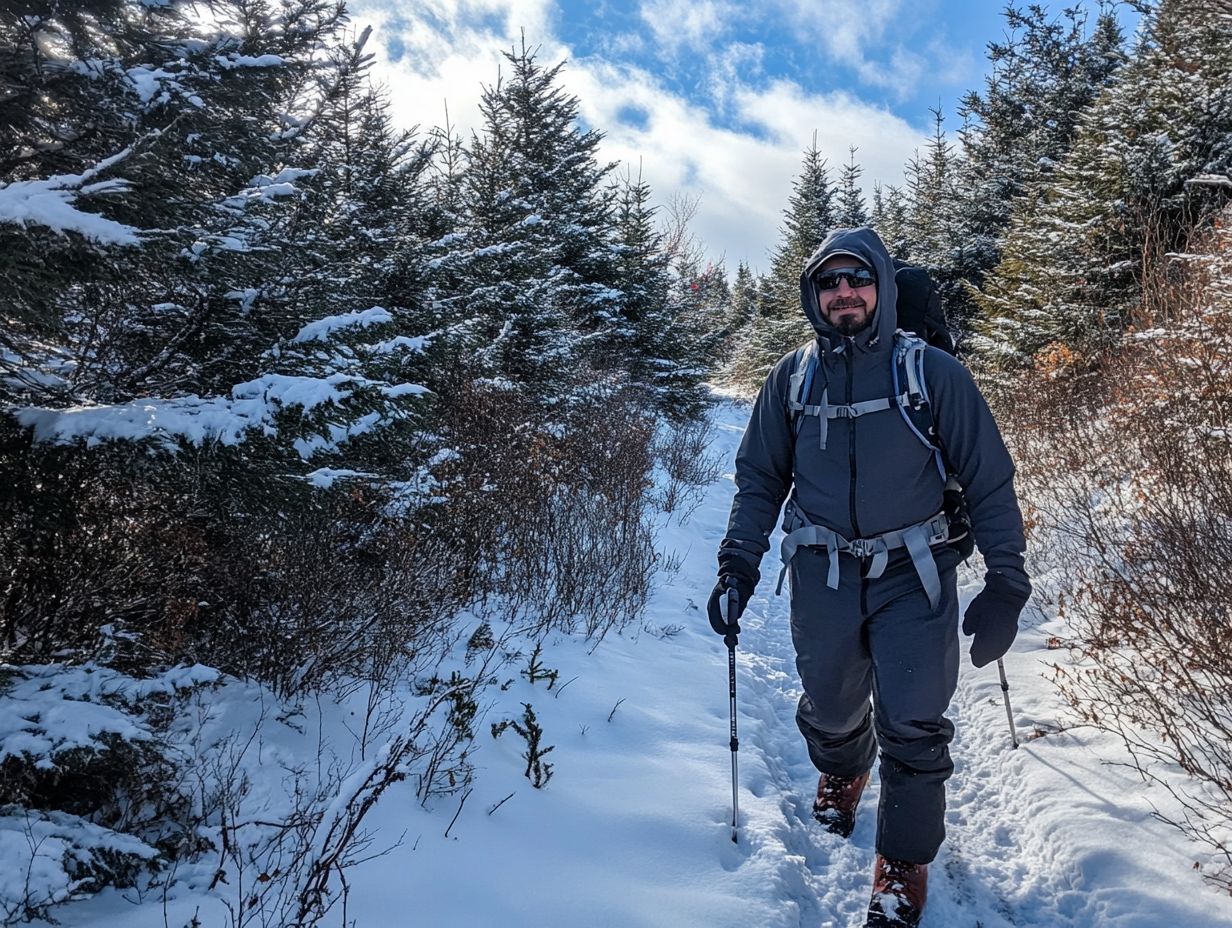
The recommended layers for winter hikes include a base layer, mid-layer, and outer layer. The base layer should be made of moisture-wicking material, the mid-layer should provide insulation, and the outer layer should be windproof and waterproof.
How should I choose the right base layer for winter hikes?
The best base layers for winter hikes are made of synthetic materials or merino wool. Avoid cotton as it retains moisture and can make you feel colder. Opt for a snug fit that allows for easy movement.
Get ready to embrace winter hikes with confidence layer up and hit the trails!
Can I wear multiple base layers for extra warmth?
You can wear multiple base layers for extra warmth. Just make sure they are made of different materials.
For example, try a synthetic base layer over a merino wool base layer for added insulation.
Is it necessary to have a waterproof outer layer for winter hikes?
A waterproof outer layer is important for winter hikes. It protects you from snow, rain, and wind.
Additionally, it should be breathable, meaning it lets moisture escape to keep you comfortable.
What about accessories for warmth on winter hikes?
Don t forget the right accessories! A warm hat, gloves or mittens, a scarf or neck gaiter, and insulated boots will keep you cozy and ready for adventure.

